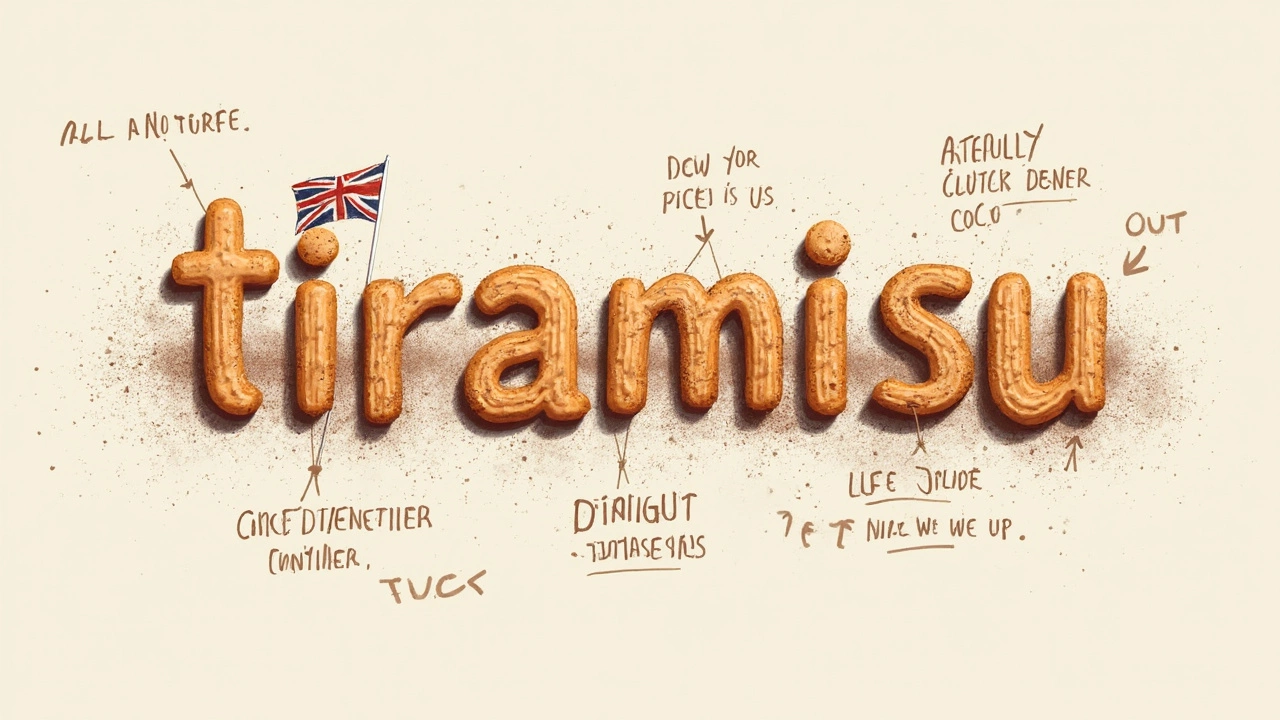Tiramisù isn't just a fancy word on that dessert menu. It's actually Italian and it screams, “Pick me up!”—literally. Ask any Italian grandma, and she’ll tell you that ‘tirami su’ breaks down to ‘cheer me up’ or ‘lift me up.’ And honestly, with one bite of creamy, coffee-soaked layers, you’ll get why they chose that name.
This isn’t just about taste, though. The name shows exactly what this treat delivers—a little jolt, thanks to a clever mix of espresso and just enough sugar to fight off the midday slump. The treat calls to you with that promise right in the name: if you’re tired, cranky, or just love dessert, tiramisù wants to save your day.
- What Does 'Tiramisù' Actually Mean?
- Roots of the Word and Italian Origins
- How Tiramisù Got Its Name
- Fun Facts and Common Myths
- Tiramisù Tips for Home Cooks
What Does 'Tiramisù' Actually Mean?
Let’s break down the word: tiramisù comes from the Italian phrase “tirami su.” If you translate this straight, it means “pick me up” or “lift me up.” People call it that for a reason—the combo of coffee, cocoa, and sugar is meant to give you a bit of an energy boost right after a meal.
But it’s not just some random nickname. Italians often use these sorts of phrases in their food, and ‘tirami su’ started showing up on menus sometime in the late 20th century. This dessert shot up in popularity because it actually delivers on the promise in its name: a sweet treat, a caffeine hit, and the kind of happiness only dessert can give.
You’ll notice that tiramisù is always spelled with that sharp-looking accent over the ‘u.’ That’s not there to be cute—it’s the Italian way to stress the last syllable, so you’re supposed to say "tee-rah-mee-SOO."
To make things even clearer, check out what you actually get when you order tiramisù:
| Main Ingredient | What it does |
|---|---|
| Espresso | Wakes you up |
| Mascarpone | Creamy happiness |
| Ladyfingers | Soaks up flavor |
| Cocoa powder | Instant mood boost |
| Sugar | Satisfies the sweet tooth |
So, whenever you see tiramisù on the menu, just know it’s not only dessert—it’s a promise to lift your spirits. That’s baked right into the name.
Roots of the Word and Italian Origins
The word tiramisù started as a blend of three regular Italian words: “tira” (pull), “mi” (me), and “su” (up). So, it’s quite direct—pull me up. Locals use it for anything that gives a quick boost, but when it comes to food, tiramisù is the king of mood-lifters. The expression popped up in the Treviso region of Northern Italy, where the dessert first got popular in the 1960s and 70s.
The dessert itself feels classic, but it’s actually pretty modern in Italian food history. Before tiramisù became a household name, locals had other layered treats, but none with quite the same kick. The mix of espresso, sweet cream, and ladyfinger biscuits set it apart and played straight into the “pick me up” meaning. Italian cookbooks didn’t even mention tiramisù until the late 1980s, so we’re talking about a treat younger than some of your favorite pop songs.
What’s really cool is that the tiramisù name spread fast. It wasn’t long before cafes in Rome, Florence, and Milan wanted their own version. Now, it’s recognized around the world, but the heart of the name and the dessert stays rooted in that small slice of Northern Italy.

How Tiramisù Got Its Name
The word tiramisù wasn’t just plucked out of thin air. This dessert first showed up in the Veneto region of Italy, likely in the city of Treviso, sometime in the late 1960s or early 1970s. The actual origin is still up for debate, but most food historians agree on this window.
Here’s the bit that matters: 'tirami su' is everyday Italian for “pick me up.” The dessert didn’t just earn this name for fun. It was created to be a mood-booster, using coffee and sugar to give you a lift. The creaminess doesn’t hurt either. According to old menus and local stories, this name started sticking as restaurant-goers kept asking for “that pick-me-up cake.”
If you’re wondering about when it became famous, it didn’t take long. By the 1980s, tiramisù was popping up in cafes all over Italy, then quickly made its way onto menus worldwide.
Some say that the original recipe was even handed out to new moms in hospitals in Treviso, because it was easy to digest, full of energy, and—yes—made you feel better. It’s a classic example of Italians naming food after what it does.
| Year | What Happened |
|---|---|
| 1960s | Tiramisù appears in Veneto region |
| 1972 | First written recipes start spreading |
| 1980s | Spreads across Italy and beyond |
- The tiramisù name is a direct call to the effect coffee and sugar have on your mood.
- It’s one of the few desserts literally named after its purpose.
- Its catchy name helped fuel its worldwide fame—everyone loves a story.
Fun Facts and Common Myths
You’ve heard all sorts of stories about tiramisù—some are true, and some are pure kitchen gossip. Let’s clear things up and get to the good stuff.
First up: people argue like crazy over where tiramisù was born. Venetians say it started in Treviso during the 1960s, tossed together by a pastry chef experimenting with leftover ingredients. On the flip side, others are sure it’s a way older treat, maybe even connected to old-time ‘pick-me-up’ desserts served to Venetian lovers. Watch out—there’s no ancient cookbook proof, though, so that’s probably just romantic talk.
Now here’s a stat to chew on:
| Fun Tiramisù Facts | Detail |
|---|---|
| Year it appeared in dictionaries | 1980 |
| Calories in a traditional slice | Approx. 400 |
| Tiramisu Day in Italy | March 21 |
Another big myth is about how to spell it. Many menus write "tiramisu,” but the real Italian spelling is “tiramisù”—with the accent on the ‘u’. Next time you spot the tiramisù with that little accent, you know they’re respecting the original.
- Tiramisù isn’t just for dessert—some Italians swear by it as a breakfast ‘energy booster’. Not everyone’s cup of coffee, but hey, no judgment!
- People think it always has booze (like Marsala wine or brandy), but that’s a choice. Classic versions often leave it out, especially for kids.
- Eggs are not always raw. Home cooks who are skittish about raw eggs can make cooked custard versions without losing the tiramisù vibe.
The best part? There’s even a World Tiramisù Championship held every year in Italy. Amateurs and chefs show off—and yes, you really can taste the difference between everyone’s family recipe. So the next time someone tries to school you about tiramisù at a party, you’ve got the facts to back you up.

Tiramisù Tips for Home Cooks
Making tiramisù at home sounds trickier than it is. You don’t need chef skills, just a few solid pointers. First off, don’t swap out real espresso for drip coffee. Authentic tiramisù depends on that bold coffee flavor—it's the backbone of the whole dessert.
Next, go for ladyfingers (savoiardi) instead of basic sponge cake. Ladyfingers don’t get soggy as fast, so the layers hold up better. And if you’re worried about raw eggs, pick pasteurized eggs or skip the eggs entirely and add a bit of whipped cream to keep the filling airy.
- Espresso: Brew it strong. You'll want about 1-1.5 cups for a classic family-size dish.
- Fresh Mascarpone: Stick to mascarpone cheese for real creaminess. Cream cheese or ricotta will change the flavor and texture.
- Avoid Over-Soaking: Dip the ladyfingers in coffee for just 1-2 seconds. Any longer and you'll end up with mush.
- Chill Time: Be patient—refrigerate tiramisù at least 6 hours, but overnight works best. This helps all those flavors get comfy together.
If you want to shake things up, try adding a dash of dark rum or coffee liqueur to your espresso. Just don’t go overboard—enough for a little kick but not so much that it overpowers everything else.
Curious what’s actually in the average serving? Check out the basics for a classic homemade tiramisù below:
| Ingredient | Typical Amount (Family Batch) |
|---|---|
| Ladyfingers | 24-30 pieces |
| Mascarpone | 500g (about 2 cups) |
| Eggs (or substitute) | 4 large |
| Sugar | 100g (about 0.5 cup) |
| Espresso | 300ml (about 1.25 cups) |
| Cocoa powder | To dust on top |
| Optional: liqueur | 2-3 tbsp |
One last thing: tiramisù is best the day after you make it, so if you want that ‘wow’ at your dinner, prep it the night before. Leftovers keep in the fridge for up to 3 days, but good luck having any left.





